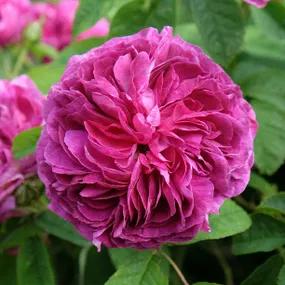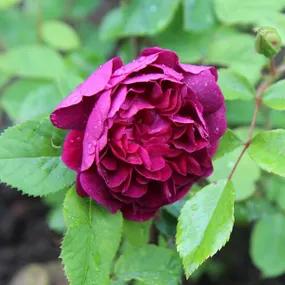Charles de Mills Gallica Rose Bushes

The details
- Height: to 1.2m
- Spread: to 1m
- Colour: Deep magenta pink
- Shape of flower: Shallow, flat, quartered
- Size of flower: Medium
- Scent: Strongly scented
- Flowering: Summer
- Group: Gallica
- RHS Award of Garden Merit
Recommended extras
Description
Charles de Mills Rose
Charles de Mills is an absolute classic that everyone will recognise. Its opulent double flowers are typical of the elegant Gallica style, little feathered-looking buds opening to reveal big, flat, quartered double blooms in deep magenta pink, which fade slowly to lilac.
Take a look at our full range of roses here.
It flowers only once, in mid summer, but it's well worth a place in your garden for that one-off hit of colour and scent. The perfume is intensely musky (Gallica roses are well known for their rich fragrance), and the petals are often used in pot-pourri, because they hold on to their scented oils really well. It is deciduous, and the arcing branches are thorny. You'll have seen it in mixed perennial borders at most National Trust properties, or used as a favourite shrub to create an informal, wildlife-friendly hedge. It holds the RHS Award of Garden Merit, meaning it's been rigorously tested and proven to be a great performer.
In the garden
Charles de Mills is lovely in a mixed border, planted towards the back, alongside cottage garden classics such as nepeta, hardy geraniums, lavender, sisyrinchium, alchemilla mollis, salvia, foxgloves and the like. It will shine inside a neatly clipped, low hedge of box or Japanese holly.
As a flowering hedge, plant en masse, or mix with another good hedging rose, such as pale pink Maiden's Blush, which is of a similar size and flowers at the same time, to create a sublime sea of pale and deep magenta pinks.
Charles de Mills in a nutshell
- Height: to 1.2m
- Spread: to 1m
- Colour: rich magenta pink
- Shape of flower: shallow, flat, quartered and double
- Size of flower: medium
- Scent: strongly scented
- Flowering: summer
- Group: Gallica
- RHS Award of Garden Merit
So who was Charles de Mills?
This beautiful rose was developed by an unknown Dutch breeder in the late 18th century. It was probably named after either Charles Mills, a director of the East India Company, or maybe after a Nottinghamshire plant breeder called Charles Mills Blyth.
Sir Francis Bacon was a fan, writing: 'They are fast flowers of their smells'. (Meaning they hold onto their scented oils well.) 'Charles de Mills has a deeply floral and resinous fragrance, akin to retsina wine.'
Planting Instructions
Needs just light formative pruning, ideally in late summer after flowering. Remove dead, damaged, diseased or congested branches. If congested, remove a few of the older stems to their base. If it has become leggy, cutting one or two stems back to 15cm above ground will encourage new growth.



